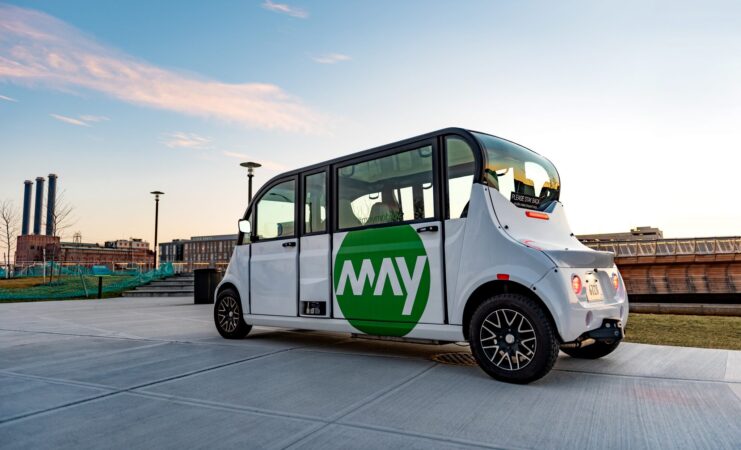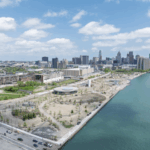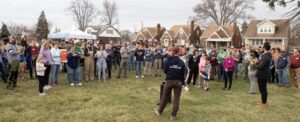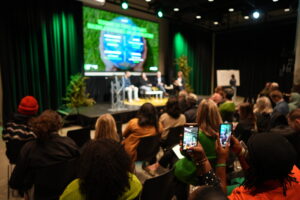As the world looks to address significant challenges like climate change in the near future, one factor comes into play, mobility. How people move to and fro has changed drastically in the past two hundred years, from the horse and buggy to the Model T, to the old wire streetcar and the rideshare electric scooter. In the face of these changes, the aspect of mobility is ever-evolving, and a group calling themselves the Future of Mobility Commission is looking to utilize all matters of new technology to build on and improve the way people get around in the 21st century.

ALISYN MALEK
Alisyn Malek, The Co-Founder and Former COO of May Mobility and Current Executive Director of the Future of Mobility Commission, has her roots in Michigan, attending engineering school at the Univerity of Michigan and working for General Motors before her time in the mobility sector. Now, she is working with a global group of individuals to come up with mobility solutions that work for all people in cities like Detroit and across the globe.
Speaking with Detroitisit, Malek talks about her background, the latest trends in the mobility sector, and the more political aspect of regulations and incentivizing new green mobility options.
What is mobility?
I grabbed a great definition from a book that I read, and I want to share that. It’s from Ghost Road, which is a great read. “With the idea of mobility, you mean, the ability to move or be moved freely and easily.” And, that definition is in contrast to this idea around transportation, which is where it’s like the system or means of moving people are good. That’s the outside view.
When we start to look at mobility, we’re thinking about how we as people move, so bringing a bit of empathy back into the system.
What does mobility look like in Detroit at the moment, and what does the future of mobility look like?
So, I think Detroit and the future of mobility, it’s really fascinating, because there’s the city of Detroit and then there’s the industry of Detroit. In the city of Detroit, I think mobility is, frankly, a bit behind where it could be.
I think DDOT is making great strides in terms of how they communicate to the public about their routes and they’re even trying to push for more efficient routes. That’s not to say that we’re not making improvements, but it’s a big city and it’s an even bigger metro area. Riding services, especially in neighborhoods that don’t have density, is a challenging situation.
When we think about mobility in the city of Detroit, it’s evolving. But it almost has an opportunity to sort of leapfrog other communities that maybe have had the ability to put in some more effort in the last 20-30 years of adding more rail lines and things like that. There’s a lot of things that we’ve learned from other communities about what works, what doesn’t work.
I think what’s exciting about the future of mobility in Detroit is the ability to learn from other communities, grab what works best, and deploy them. If you look at the Office of Mobility Innovation, they’ve been doing a lot of great projects. But I think the other part is, there’s so much changing right now that they’re thinking about what outcomes you want to see and then what is the potential to achieve that?
I think that the city of Detroit provides a great place to be able to try out new ideas and figure out how to scale.
You mentioned learning from other communities. What types of experiments could we see in Detroit that have come from other cities?
I think every city is trying to figure out how to get better access for their constituents to their daily needs. If you look at cities like Paris, for instance, they’re just getting rid of a whole bunch of parking and turning it over to bike lanes. They’re really trying to think about how their constituents can access their daily needs without a vehicle. When we look at the city of Detroit, we have to recognize there’s a lot of people that you have cars, how would like to continue to use them. But, there’s plenty that doesn’t and some for whom it doesn’t make economic sense.
So how can we think about those people, both from a mobility perspective of how they get around, but also thinking about where are they going, what do they need, can mobility maybe help bring those things to them? And that’s where I think we’re going to be seeing a lot more innovation.
So, a history lesson of the last 12 years in mobility innovation. Uber and Lyft took cities by storm and just surprised them. They showed up with a service that doesn’t serve all communities, doesn’t go into some neighborhoods, have less coverage than others, that type of stuff. When you think about a city’s goals to help all of its residents and Uber and Lyft’s goals, they were not aligned.
Cities learned from that experience. When you watched the rollout of scooters and other types of micro-mobility, we saw cities were much quicker to get involved. I think now we’re getting to this place where on the innovation side, there’s an understanding that there has to be some alignment with the city’s needs and serving everybody, as opposed to just fighting it tooth and nail the whole way through.
That is where Detroit, looking forward to all the innovation that is going on, is well suited to learn from some of these histories.
How involved will the Future of Mobility Commission be with some of the new innovations occurring such as what’s underway at Michigan Central Station with Ford?
With the commission, we’re working now on identifying what our key focus areas will be because our mandate is quite broad. And so after that deliberation process, if it makes sense to be partnering on experiments, or something like that, in the city of Detroit we’ll absolutely do it. But there’s also the case where the things they end up focusing on may not quite align.
Michigan Avenue, which connects the train station to downtown and also connects out to Dearborn and into Ann Arbor, that’s a really useful hub. Figuring out how to connect those dispersed neighborhoods in the area and connect them to other homes and transportation, I think there’s going to be a lot of opportunity in that way. That’ll be exciting to see.
You mentioned Ann Ann Arbor. When looking at mobility, how important is it to connect a city like Detroit with Ann Arbor?
I think closing what I joke is the “space-time continuum,” closing that gap, I think is very helpful, because then you can drive cross-pollination of people and ideas. And, that’s where the magic happens.
Because so much of the auto industry kind of goes out towards Plymouth, and then north all the way to Auburn Hills, there’s just this whole ecosystem, where a lot’s going on, it’s very beneficial that Ann Ann Arbor is just beyond Plymouth. I think creating more easier access between the two hubs can create more opportunities like I said. So that cross-pollination where you’ve got more tech startup people, learning from industry veterans, more industry veterans getting new ideas from tech startup people, I think that’s what becomes really exciting. It can create more opportunities for that coming together.
So Self-Driving vehicles, what does the technology look like and how would that technology help with improving challenges like congestion?
So, in terms of the state of the technology, it’s made strides, but it’s still not there yet. In terms of ready for primetime all-weather, all environments, it’s also not there yet, there’s still work to be done.
The technology needs to get there on the engineering side of things, there’s getting it to do drive safely, even in snow. Then there’s getting it to do it reliably and those are two different kinds of bars. Just because you can do something once doesn’t mean you can do it a million times and when you work in automotive engineering, there are thousands of test cycles for like how much you open and close doors to make sure the hinges don’t break. And that’s where I’m talking about reliability.
This is exciting for the conversation right now is how do we create standards around reliability and safety? That, to me demonstrates a much more advanced level of conversation, which is exciting. It’s a level of maturity to be at that point.
The question about congestion, like everything else to do with automation, it can go any way possible. It’s going to the business models within which we use automation that will drive whether or not we have congested streets.
So how do we incentivize these new greener mobility options so that they’re more wide-spread?
That is exactly what I want to work on with the commission. For those who can afford it, education becomes a big thing, education, and access to charging. Once you understand the total cost of ownership, which, although the initial price for EVs has been higher than their gasoline-powered counterparts, it’s changing. I think in the next decade they’ll be the same price.
But even then, looking at your monthly costs, like when I was driving to Ann Arbor every day, I had a monthly budget for how much I was spending on gas. It would have been less if I had been driving an EV because electricity is just less expensive.
So there’s a big part around education and helping people feel comfortable with the technology, and that it can do what they need to do that they won’t get stranded, stuff like that is really important.
And as we think about further providing access to each of these individuals, who are our lower-income, maybe they don’t have a car today, I think that’s where these community-based mobility approaches are going to get really interesting. So maybe there’s a car share where a community can share access to an electric vehicle. We’re also getting far enough along that now you can get a used electric vehicle, so the cost is way down.
Between self-driving and electric vehicles, where do other mobility options like rail and scooters fall into the picture?
So this is where I think I get most frustrated with Michigan. Detroit is the Motor City, so much of how we think about transportation is, well, the car. But when we look at other cities in the US, and very much so other cities globally, it’s an ecosystem with many options.
When we’re talking about hyperloop and rail and micro-mobility, all of those things need to exist, including cars, we happen to be very car-dependent as a region. It hasn’t always been that way and it doesn’t always have to be that way.
As I think about what role Hyperloop, micro-mobility, and cars play, I think about it more from a job to be done perspective. If the job is to move one person, one mile, and they don’t have to carry a bunch of stuff, and they’re able-bodied and the weather is good, take a scooter or walk. If you need to move 1000 people at the same time five miles, a train makes a lot of sense.
For these solutions, it’s not that they all go away when there are autonomous vehicles; it’s that we will hopefully figure out the right size vehicle for the right job to be done.
On the political side of mobility, how do you enforce things such as emission standards and other aspects that could lead to a more green transportation system?
What’s interesting is that as transportation goes fully electric, emissions conversation goes away. So one of the things we’re thinking about from the commission’s perspective is, what are the right conversations to be having right now to actually drive the outcomes we want to see?
Do we want more gasoline efficient vehicles? Or do we want electric and hydrogen-powered vehicles? Because if we want electric and hydrogen-powered, then the focus on emissions isn’t actually helping us get to that future.
And so that’s where I think we have to recognize what the outcomes are you’re actually trying to drive towards. And we need to make sure that the policies that are in place are doing that.
Can you explain how we can see policy and regulation work together?
It’s very critical. When you think about it, California now has requirements, that by 2035, all vehicles sold in California must be electric. In order to meet that, there needs to be a policy that makes sure that everything else is in place, make sure there’s enough charging infrastructure to support all those vehicles that will be coming online, making sure that there are enough technicians trained to be able to support those things. So policymakers need to support their constituents.
When we put that as the framework that we’re thinking about, helping to make sure that if there’s enough workforce training, or making sure that the local utility commission is able to allow the utilities to install charging infrastructure. That’s all policy and regulatory work that can happen in tandem to meet that goal of fully electric vehicles by 2035.






















